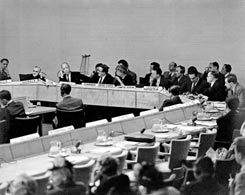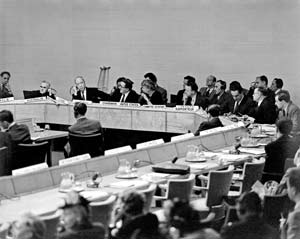
When the General Assembly of the United Nations adopted, on 10 December 1948, the Universal Declaration of Human Rights, in one of the brief spells of enlightenment in the twentieth century, one could hardly anticipate that a historical process of generalization of the international protection of human rights was being launched, 0n a truly universal scale. Throughout the last six decades, of remarkable historical projection, the Declaration has gradually acquired an authority which its draftsmen could not have foreseen. This happened, not only because of the persons who participated in its elaboration, nor because of the form which was given to that historical document, nor because of the circumstances of its adoption: it happened mainly because successive generations of human beings, from distinct cultures and all over the world, recognized in it a “common standard of achievement” (as originally proclaimed), which corresponded to their deepest and most legitimate aspirations.

Already throughout the travaux préparatoires of the Universal Declaration (particularly in the thirteen months between May 1947 and June 1948), the holistic view of all rights to be proclaimed promptly prevailed. Such outlook was espoused in the official preparatory work of the Declaration, that is, the debates and drafting in the United Nations Commission on Human Rights and subsequently in the Third Committee of the General Assembly. In addition, in 1947, in a contribution to the work then in course in the Commission on Human Rights, the United Nations Educational, Scientific and Cultural Organization undertook an examination of the main theoretical problems raised by the elaboration of the Universal Declaration; it circulated, to some of the most influential thinkers of the time around the world, a questionnaire on the relations between rights of individuals and groups in societies of different kinds and in distinct historical circumstances, as well as the relations between individual freedoms and social or collective responsibilities.
Some of the answers to the questionnaire singled out the interdependence of all human rights, the guarantee of freedom of the individual in face of the forces of collectivity and of situations of adversity, and the relations between rights and duties. The 1948 Universal Declaration stressed the interdependence of all human rights (civil, political, economic, social and cultural), all inherent in the human person. Shortly after its adoption, conceived as the first of a three-part International Bill of Human Rights (that was to be followed by a Convention – which later resulted in the adoption of the two Covenants – and measures of implementation), the deep ideological divisions of the world of the 1950s led to the categorization of human rights.
It was not until the first International Conference on Human Rights (Teheran, April to May, 1968), two decades after the adoption of the Universal Declaration, that the reassertion of the holistic view and interrelatedness of all human rights (nowadays universally acknowledged) took place, in a world then divided by the bipolarity characteristic of the cold war. Such reassertion, reiterated in successive resolutions of the United Nations General Assembly, has generated a considerable transformation in the treatment of human rights matters at the international level ever since. When the 1968 Teheran Proclamation forcefully advanced the thesis of the indivisibility of all human rights, it was rescuing the basic philosophy underlying the Universal Declaration in this regard.

With the gradual adoption of United Nations sectoral human rights conventions and the operation of several international supervisory organs thereunder, it was not surprising that, 25 years after Teheran, the Declaration and Programme of Action of Vienna, adopted by the second World Conference on Human Rights (Vienna, June 1993), was marked by the recognition of the necessity to achieve a better coordination of the several international instruments of protection, which had coexisted in the previous two and a half decades. The Teheran Proclamation corresponded to the legislative phase, and the Vienna Declaration and Programme of Action to the implementation phase, of those multiple instruments of protection. Each one is a product and testament of its time.
The second World Conference concentrated its attention on the means to secure the effectiveness of human rights in practice, with special attention turned to discriminated or disadvantaged persons, to vulnerable groups, to the poor and to all those who are socially marginalized or excluded, in sum, to those in greater need of protection. It gave concrete expression to the interdependence of all human rights and their universality (enriched by cultural diversity).
The 1948 Universal Declaration of Human Rights is widely recognized as having inspired, and paved the way for, the adoption of more than seventy human rights treaties, applied today on a permanent basis at global and regional levels (all containing references to it in their preambles). In addition, the Universal Declaration served as a model for the enactment of numerous human rights norms in national constitutions and legislations, and helped to ground decisions of national and international courts. The Universal Declaration, moreover, is today widely recognized as an authoritative interpretation of human rights provisions of the Charter of the United Nations itself, heralding the transformation of the social and international order to secure the enjoyment of the proclaimed rights.
General awareness was gradually formed of the existence of rights which are inherent in all human beings, which thus pre-exist, and stand above, the State and all forms of political organization. There was general acceptance of the corollary of this, namely that the safeguarding of such rights emanates from the law of nations itself, and is not exhausted – nor can it be exhausted – by the action of States. The international community as a whole, moved by the universal juridical conscience, conferred upon the Universal Declaration the dimension that it has today, recognized in the international case law, incorporated in the domain of customary international law, and gave expression to some general principles of law universally recognized. The Universal Declaration has thus much contributed to render human rights the common language of humankind.
Yet, in this first decade of the twenty-first century, there still remains a long way to go in order to achieve the plenitude of the international protection of human rights. There is great need to conceive new forms of protection of human beings. Virtually all the existing mechanisms of protection were conceived as responses to different kinds of human rights violations. The current concern of international organs of protection, faced with continuing violations of human rights, to develop measures both of prevention and of follow-up, has its raison d'être. Such measures would tend to establish and consolidate a system of continuous monitoring of the observance of human rights anywhere, pursuant to the same criteria. Such monitoring would constitute, ultimately, the response, at the procedural level, of the recognition obtained at the second World Conference on Human Rights in 1993 of the legitimacy of the concern of the whole international community with human rights violations everywhere and at any time.

The advances of the international protection of human rights depend nowadays, to a large extent, on national measures of implementation. The emphasis on such national measures is without prejudice to the preservation of the international standards of protection. In the present domain of protection, international law and domestic law are in constant interaction. It is the international protection itself which requires national measures of implementation of human rights treaties, as well as the strengthening of national institutions linked to the full observance of human rights and the rule of law (État de Droit). The application of international norms of protection aims at improving, rather than challenging, domestic norms, to the benefit of all protected human beings. To this, one could add the complementarity between global (United Nations) and regional mechanisms of human rights protection, on distinct continents. Regional systems of protection operate within the framework of the universality of human rights.
The protection of human rights nowadays occupies a central position in the international agenda of the twenty-first century. At the global level, the multiplicity of international instruments in the present domain discloses a fundamental unity of conception and purpose. The 1948 Universal Declaration – the starting point – retains its vigour six decades after its adoption. With remarkable foresight, the Universal Declaration propounded a particularly comprehensive principle of non-discrimination and called for the transformation of societies in order to secure the effective enjoyment by everyone of the protected rights.
Turning our eyes to the past as well as to the future, it is undeniable that there have effectively been, in these six decades since the adoption of the l948 Universal Declaration of Human Rights, considerable advances, above all in the process of jurisdictionalization of the international protection of human rights. This is a domain of protection which admits no steps backwards, and which has been contributing, more than any other branch of the law of nations, to the gradual expansion of the material content of jus cogens, besides disclosing the pressing need today to consolidate erga omnes obligations of protection. Such developments have been due to the universal juridical conscience, as the ultimate material source of International Law, and indeed of all Law. They keep on asserting the universality of human rights at both normative and operational levels – as lucidly propounded six decades ago by the Universal Declaration of 1948.
This Introductory Note was written in 2008.Related Materials
United Nations Educational, Social and Cultural Organization, Human Rights Comments and Interpretations: A Symposium edited by UNESCO, with an introduction by Jacques Maritain, Columbia University Press: New York, 1949 (See Appendix I (questionnaire) and Appendix II (report)).
Vienna Declaration and Programme of Action, World Conference on Human Rights, Vienna, 14 to 25 June 1993, United Nations Doc. A/CONF.157/23 (1993).
At the United Nations Conference on International Organization, held at San Francisco in 1945, it was suggested that the United Nations Charter should contain a bill of rights. The Committee I/1 of the Conference decided that “the present Conference, if only for lack of time, could not proceed to realize such a draft in an international contract”. The Committee recommended that the General Assembly of the future organization would consider the proposal and give it effect.

The Preparatory Commission of the United Nations, which met immediately after the closing of the San Francisco Conference, recommended that the Economic and Social Council should, at its first session, establish a commission for the promotion of human rights as envisaged in Article 68 of the Charter. Accordingly, on 15 February 1946, the Economic and Social Council established a Commission on Human Rights in nuclear form to report on the functions and scope of work of the projected Commission on Human Rights. The nuclear Commission recommended that the full Commission on Human Rights should prepare an international bill of rights. Based on this recommendation, the Council, by resolution 9 (II) of 21 June 1946, adopted the terms of reference of the permanent Commission on Human Rights, which included, inter alia, to submit proposals, recommendations and reports on an international bill of human rights. Accordingly, at its first session, the Commission, composed of 18 Member States, decided to establish a Drafting Committee to formulate a preliminary draft of such a bill, to be submitted to the Commission at its second session. To assist the Drafting Committee in its work, the Secretariat prepared a Draft Outline of the International Bill of Human Rights (E/CN.4/AC.1/3 and Add.1).
The members of the Drafting Committee disagreed as to the form of the draft bill. While some representatives favoured a declaration that could be accompanied or followed by a convention or conventions on specific groups of rights, other representatives preferred the form of a convention with legally binding obligations. With regard to the latter option, it was agreed that the Assembly, when adopting the convention, could make a broader and more general declaration. In light of the fact that the decision as to the form of the bill was a matter for the full Commission, the Drafting Committee submitted two texts for its consideration, one preliminary draft of an international declaration and one of an international convention on human rights (E/CN.4/21).

At the Commission’s second session, the notion of an international bill of human rights consisting of three parts (namely a declaration, a convention (which it renamed “covenant”) and measures for implementation) began to crystallize. The Commission thus established three working groups on these items. Another result of the Commission’s session was a report (E/600) on the measures for implementation which remained a basic document for all subsequent study in the field.
At its third session, the Commission, which based its work on the report of the second session of the Drafting Committee (E/CN.4/95), completed the redrafting of the declaration, which was adopted without opposition. It had neither time to consider the draft covenant, which had been redrafted in its entirety by the Drafting Committee, nor to discuss the question of implementation. The Economic and Social Council considered the report of the Commission’s third session (E/800), which contained the text of the draft International Declaration of Human Rights, in plenary, on 25 and 26 August 1948. Thereafter, it decided to transmit to the General Assembly the draft Declaration for consideration.
The General Assembly, at its 142nd meeting held on 24 September 1948, referred to the Third Committee the draft Declaration, which considered the item at its 88th to 105th, 107th to 116th, 119th to 134th, 137th to 167th and 174th to 179th meetings, held, respectively, from 30 September to 18 October, 19 to 29 October, 30 October to 12 November, 15 to 30 November, and 4 to 7 December 1948. Altogether, the Third Committee spent eighty-one meetings considering the draft Declaration prepared by the Commission on Human Rights. One hundred and sixty-eight formal draft resolutions containing amendments to various articles of the draft Declaration were submitted during the course of the Committee’s debate. At its 178th meeting, the Third Committee adopted the draft Declaration by a roll-call vote of 29 to none, with 7 abstentions.
The report of the Third Committee (A/777) was considered at the 180th to 183rd meetings of the General Assembly, on 9 and 10 December.
On 10 December 1948, the General Assembly adopted by a vote of 48 to none, with 8 abstentions, resolution 217 (III) entitled “International Bill of Human Rights”.
Sources:
- Official Records of the Third Session of the General Assembly, Part I, Plenary meetings of the General Assembly, Summary Records of Meetings, 21 September – 12 December 1948.
- United Nations Yearbook (1946-47 and 1948-49).
- Fact Sheet No. 2 (Rev.1), The International Bill of Human Rights, Official website of the Office of the High Commissioner for Human Rights: www.ohchr.org
Selected preparatory documents
(in chronological order)
Economic and Social Council resolution 9 (II) of 21 June 1946 adopting the terms of reference of the Commission on Human Rights
Draft Outline of the International Bill of Human Rights prepared by the Secretariat (E/CN.4/AC.1/3 and Add.1)
Report of the Drafting Committee of the Commission of Human Rights (E/CN.4/21)
Report of the third session of the Commission on Human Rights (E/800, annex A (Economic and Social Council Official Records, 7th session, Supplement No. 2))
Report of the Economic and Social Council on draft Declaration to the General Assembly (A/632)
Third Committee of the General Assembly, Summary records of meeting nos. 88 to 95 (discussion in connection with the Bill of Human Rights) (A/C.3/SR.88, A/C.3/SR.89, A/C.3/SR.90, A/C.3/SR.91, A/C.3/SR.92, A/C.3/SR.93, A/C.3/SR.94 and A/C.3/SR.95)
Third Committee of the General Assembly, Summary records of meeting nos. 95 to 179 (discussion by article) (A/C.3/SR.95-179)
Report of Sub-Committee 4 to the Third Committee (A/C. 3/400/Rev. 1)
Report of the Third Committee to the General Assembly (A/777)
General Assembly, Verbatim records of meeting nos. 180 to 183 (A/PV.180, A/PV.181, A/PV.182 and A/PV.183)
General Assembly resolution 217 (III) of 10 December 1948 containing the text of the Universal Declaration of Human Rights

| Interviews by United Nations Radio | ||
 Statement by Mrs. Eleanor Roosevelt, Representative of the United States and Chairperson of the Commission on Human Rights, 17 June 1948: Mrs. Roosevelt explains the difference between the Universal Declaration of Human Rights and the Covenant, the impact of public opinion on the Declaration and how the Declaration will benefit the ordinary person. Statement by Mrs. Eleanor Roosevelt, Representative of the United States and Chairperson of the Commission on Human Rights, 17 June 1948: Mrs. Roosevelt explains the difference between the Universal Declaration of Human Rights and the Covenant, the impact of public opinion on the Declaration and how the Declaration will benefit the ordinary person. English (8 minutes) | ||
 Statement by Mr. Charles Malik, Representative of Lebanon and Chairman of the Third Committee, 6 November 1948: Mr. Malik describes the work of the Third Committee towards a Universal Declaration of Human Rights. Statement by Mr. Charles Malik, Representative of Lebanon and Chairman of the Third Committee, 6 November 1948: Mr. Malik describes the work of the Third Committee towards a Universal Declaration of Human Rights. English (3 minutes) | ||
15 November 1947
Second session of the General Assembly, 114th plenary meeting, Flushing Meadows, New York
[Read more]
December 1950
United Nations International Nursery School,
New York
[Read more]
Codification Division, Office of Legal Affairs
Copyright © United Nations, 2023. All Rights Reserved.
Terms and Conditions of Use.